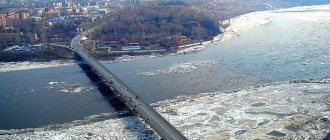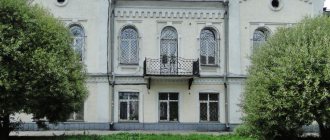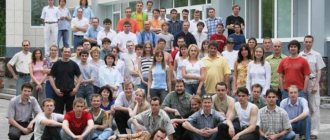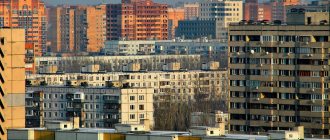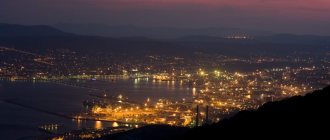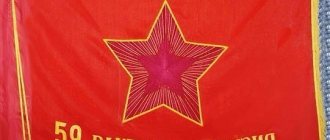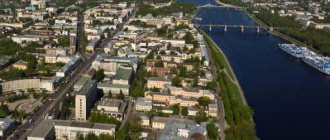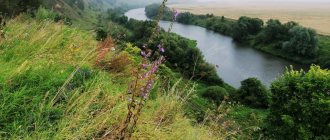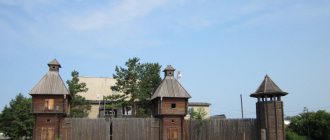The city of Volgodonsk is located in the southeastern part of the Rostov region and was founded in 1950. Volgodonsk is a large commercial, industrial, geographical and scientific center of the Rostov region, the energy center of the south of the Russian Federation. Within the city limits there is a nuclear power plant Volgodonsk NPP (Rostov) and the largest industrial association in the Russian Federation "Atommash" (nuclear power engineering industry).
In 1949, the construction of the Volga-Don shipping canal began, a village with temporary infrastructure was erected for builders and engineers, but the number of workers grew, and there was not enough housing for everyone, so the need arose to expand the village and its infrastructure. These are the origins of the future city of Volgodonsk.
General information and history of the city
Volgodonsk is a very young city; three generations of residents have not yet replaced it.
The city owes its appearance to a gigantic Soviet construction project - the digging of the Volgodonsk Canal, connecting two great Russian rivers - the Don and the Volga. Work began in 1949, thousands of workers arrived, and a settlement was organized to house them. The workers' settlement Novo-Solenovsky, intended after construction for the residence of workers servicing the Tsimlyansky hydroelectric complex, and in it in 1950 the industrial construction of multi-storey buildings began. This date became the founding day of Volgodonsk.
Volgodonsk in Soviet times
In 1958, a huge chemical plant was built, and the workers' settlement was given the title of city. In 1975, it was launched, and to improve the life of its workers, they began to build up the left bank of the Sukho-Solenovsky Bay of the Tsimlyansk Reservoir, the current New Town.
In 1977, it was decided to build a nuclear power plant in Volgodonsk. Work had begun, and the first building was almost completely erected when the explosion occurred at the Chernobyl nuclear power plant. Residents of the city, frightened by such a prospect from the use of nuclear energy, and even fueled by city politicians (who made a career out of it), organized pickets and rallies. As a result, in 1990, a decision was made to stop construction.
Embankment in Volgodonsk. Monument to Cossack General Ya.P. Baklanov
The nineties of the last century were difficult for the city. The city-forming enterprise, Atommash, received 2 times fewer orders than before, unemployment increased and the criminal situation worsened. In this situation, a decision was made in 1998 to resume construction of the nuclear power plant, which was commissioned in 2001, giving work to thousands of citizens.
Although the city was built after World War II, it cannot be said that it did not see the horrors of war. On September 16, 1999, at six o'clock in the morning, a residential building on Oktyabrskoye Highway was blown up. The attack killed 18 people.
House damaged in terrorist attack
Currently, the city is experiencing a rebirth; the influx of investment in industry and construction has increased significantly.
Climate and ecology of Volgodonsk
The city is located in an area with a temperate continental climate. Winters are warm and with little snow, the average temperature of the coldest month of January reaches -5.6˚С. You can wear a fall coat all winter and not experience discomfort. Summer is warm, in July the air warms up to +28.8˚С. The heat is tolerated in Volgodonsk much more easily than in many steppe cities due to the proximity of a large reservoir - the air cools significantly above the water surface and cool winds blow in the city.
Winds predominate from the east and northeast. When constructing the industrial zone and residential complex of the city, Soviet architects took into account the direction of the wind, so residential neighborhoods receive virtually no emissions from industrial enterprises.
CHPP-2
Until 2007, Volgodonsk was on the list of the most polluted cities in Russia, but now the environmental situation is improving. The largest emissions into the air come from CHPP-2 and CHPP-1, and the Volgodonsk wood panel plant. The share of pollution from road transport is also high (more than 90% of total air pollution).
The problem with storm drainage has not been resolved; most of the drains flow directly into the Tsimlyansk Reservoir. There are 19 radiation monitoring points around the Rostov NPP and in the adjacent areas of the region. Background radiation data is broadcast in every weather forecast for the entire region.
Links[edit]
Notes[edit]
- ^ abcde Law No. 340-ZS
- ^ ab Encyclopedia of Russian Cities
. Moscow: Great Russian Encyclopedia. 2003. p. 86. ISBN 5-7107-7399-9. - ^ a b Federal State Statistics Service (2011). “All-Russian Population Census 2010. Volume 1" [All-Russian Population Census 2010, vol. 1]. All-Russian Population Census 2010 [All-Russian Population Census 2010]
. Federal State Statistics Service. - "26. The size of the permanent population of the Russian Federation by municipalities as of January 1, 2022". Federal State Statistics Service. Retrieved January 23, 2022.
- ^ abc Law No. 186-ZS
- "On the Calculation of Time". Official Internet portal of legal information
. June 3, 2011. Retrieved January 19, 2022. - Post office. Information and computing center of OASU RPO. ( Post office
).
Search for postal service objects ( postal Search for objects
) (in Russian) - ↑
Federal State Statistics Service of Russia (May 21, 2004).
“The population of Russia, the constituent entities of the Russian Federation as part of federal districts, urban settlements, settlements, settlements of 3 thousand or more people” [Population of Russia, its federal districts, federal districts, districts, urban settlements, rural settlements - administrative centers and rural settlements with a population of more than 3,000 people] (XLS). All-Russian Population Census 2002
. - “All-Union Population Census of 1989. The current population of union and autonomous republics, autonomous regions and districts, territories, negative phenomena, urban settlements and rural district centers” [All-Union Population Census of 1989: current population of union and autonomous republics, Autonomous regions and districts , territories, regions, districts, urban settlements and villages performing the functions of district administrative centers. All-Union Population Census of 1989 [All-Union Population Census of 1989]
.
Institute of Demography of the National Research University: Higher School of Economics [Institute of Demography of the National Research University: Higher School of Economics]. 1989 - via Demoscope Weekly
.
Population of Volgodonsk
The population of Volgodonsk increased disproportionately. Each new Soviet global construction project led to the arrival of an army of thousands of young enthusiasts to the city, many of whom remained in the city.
When the city was founded, there were not even 10 thousand people in it. Just 10 years later, when the Chemical Plant was built, there were 20 thousand in the city. With the commissioning of Atommash, the population increased to almost 100 thousand. Human. The maximum was observed in 1992, when 191 thousand Volgodonsk residents were counted in the city. The crisis in the country has made itself felt, and now only 170 thousand residents remain in Volgodonsk.
The mortality rate in the city corresponds to the regional average, but more young Volgodonsk residents are born than in other Don cities. The city's problem is the high mortality rate of people of working age. The average age in the city is 65.4 years.
The peculiarities of the character of the population are largely related to the specifics of the settlement of the city. Today's youth are the descendants of those socially active Komsomol members who came here in the middle of the century. People in the city are active; I prefer to participate in solving their problems rather than trust others to do so. Very sociable and friendly. Although every barrel of honey has its fly in the ointment, and in the city you can meet boors and rude people. But this is the exception rather than the rule.
Youth Day
Famous people[edit]
- Vitaly Kazantsev (born 1981), Russian football coach and former player
- Alexey Germashov (born 1982), Russian professional football player
- Alexander Omelchenko (born 1983), Russian professional football player
- Olga Belyaeva (born 1985), Russian water polo player
- Nikita Borisoglebsky (born 1985), Russian violinist
- Dmitry Kudryashov (born 1985), Russian professional boxer, current WBA world heavyweight champion.
- Anna Grineva (born 1988), Russian water polo player
- Anna Ustyukhina (born 1989), Russian water polo goalkeeper
- Ekaterina Prokofieva (born 1991), Russian water polo player
- Yulia Efimova (born 1992), Russian swimmer
- Nastya Tyman (born 1992), auto mechanic-reanimator, vlogger.
- Identify a musician
Districts and real estate of Volgodonsk
Most cities have been built over centuries, and they have a clearly defined historical center and residential outskirts - new buildings. Volgodonsk was built and designed according to the urban planning standards of the USSR, that is, with developed infrastructure, schools and kindergartens within walking distance.
At first, only the city was built, located on the right bank of the Sukho-Solenovsky Bay of the Tsimlyansk Reservoir. This is the so-called old city. There is no division into named areas. In the city, neighborhoods are designated by numbers. Residential areas are located near the shore, and the industrial zone is located outside the city boundaries.
Volgodonsk Map
During the construction of Atommash, they immediately began to build a residential complex for its workers - a new city. In this part of Volgodonsk, blocks are also marked with an alphanumeric code, for example V-5 or VTs-3.
When designing a new district of the city, in all official documents of the designers, the letter “B” designated the Eastern District, and was the working construction wording. After construction, a competition was even held for the best names of the blocks, but they never caught on, except for V - “Oktyabrsky”, V-7 - “Yubileiny”.
New town
Conventionally, the New and Old Towns can be divided into their northern, central and southern parts. In the New Town, only the southern and eastern parts are built up, a little in the center.
In the north of the Old Town, a one-room apartment costs from 1.3-1.4 million rubles, in the center - from 1.4-1.5 million rubles, on the southern outskirts - from 0.8-0.9 million. rub. The houses in the area are mostly executive class, with at least 130 m2 of total area; you can buy such apartments for a price starting from 7 million rubles.
In the New City, one-room apartments cost 1.4-1.6 million rubles, two-room apartments 2.0-2.3 million rubles, houses from 8 million rubles.
Old city
It is simply impossible to definitely decide which area of the city is more suitable for living; each has its own advantages. Ask a citizen from the Old Town, and he will say that life is better here, cozy brick “Khrushchev” apartments, quiet, peaceful life, plenty of greenery and parks. There are a lot of young people on the street, since educational institutions are located in this part of the city.
In response to the same question, a resident of the New City will begin to praise his part of Volgodonsk. They say that the New Town is mainly inhabited by nuclear power plant workers, intelligent people who earn a lot of money, the infrastructure is developed, and housing in prefabricated houses of the Brezhnev era is, for good reason, more expensive than in the Old Town. New entertainment centers, shops, and parks have opened in the New Town. Each part of Volgodonsk has its own pros and cons.
City infrastructure
Problems in the city's infrastructure are the same for all districts. Engineering communications have not yet worn out, but the quality of the provided utilities is not always up to par. Every year during warm weather the hot water is turned off. There are power outages. At the same time, payments on utility bills are almost as high as in Rostov-on-Don. In many areas, new cottage communities have been built, which is why the water pressure of nearby high-rise buildings only reaches the 7th floor.
Residents of such large streets as Gagarina, Entuziastov, Morskaya, Stepnaya, Stroiteley and Kurchatov Avenues experience discomfort from high gas pollution from dense traffic flow. It should be noted that almost all the streets of the city are well lit at night.
Volgodonsk. Stroiteley Avenue
The situation with kindergartens and schools in Volgodonsk is good (but not excellent). Thanks to the competent layout of the city, it takes no more than 10 minutes to walk from each residential building to the kindergarten. In total, there are 19 schools in the city, with 12 thousand students. Secondary vocational education can be obtained at one of 12 professional institutions (in almost any popular specialty).
The situation with universities is more than interesting. Previously, there were 8 universities in the city, all branches. The largest of them was formed in 1978. branch of the Novocherkassk Polytechnic Institute (now SRSTU (NPI)). The university worked quietly and successfully for 40 years, until in 2009 a branch of MEPhI (Moscow Engineering Physics Institute) was formed on its basis. And in 2012, immediately after accreditation, an order from Moscow simply closed the branch of SRSTU (NPI) without explanation, transferring its premises to MEPhI. No one thought about the students. Those of them who were lucky and had duplicated majors at universities were allowed to transfer to MEPhI on a paid basis. The rest, in order to complete their studies, were forced to transfer themselves to Rostov or the head branch of Novocherkassk.
MEPhI
Officially, everything is excellent with healthcare in Volgodonsk: 3 hospitals, a maternity hospital, 3 clinics, including a dental clinic. In fact, to see a doctor at a municipal clinic, you need to take a coupon. The estimated time for visiting a doctor using a coupon is 5 minutes. A second line forms right next to the office for those who have a second appointment. They don't give coupons. It turns out that in 5 minutes the doctor must see two patients at once. What effective treatment can we talk about with such a scheme?
In addition to your car, you can move around Volgodonsk by trolleybus (9 routes and 10 rubles per ticket), buses (30 routes and 10 rubles per ticket) and minibuses (6 routes, 14 rubles). A distinctive feature of the organization of transport in Volgodonsk is the presence of the so-called linear taxi: private cars for 20 rubles will take you along a predetermined linear route with stops. So everything is ok with transport.
But the roads are not so rosy. Every spring, potholes on the main streets of the city are filled in panic. But this is the case everywhere in Russia.
Despite the presence of a powerful nuclear power plant within the city, the railway network in the city is not electrified. Trains arrive here from Rostov-on-Don every day. express trains.
Railway station
There is also an airport in the city. True, it has not worked for several decades.
The city has a developed sports movement: three teams of masters consistently perform in the top leagues of Russia, the regional football team attracts full stands of fans. This situation is explained by the presence of good sports facilities (stadiums, sports complexes, swimming pools) built in Soviet times. Over the past 20 years, no sports facilities have been built in the city.
Map of Volgodonsk with houses
The housing stock of Volgodonsk consists of multi-storey complexes and only on the outskirts of the city are there private houses. Residents of high-rise buildings are forced to endure the constant noise of city streets and increased pollution, since the city has a large number of vehicles and highways. The location of residential apartment buildings can be seen on the map of Volgodonsk with houses.
The city's infrastructure is well thought out and very convenient for Volgodonsk residents. Each microdistrict has a school and kindergartens, the walking distance to which does not take more than 10 minutes. Many shopping centers, cinema theaters, and restaurants have been built.
The city has excellent health care facilities. Here are:
- 3 city hospitals;
- Dentistry;
- Maternity hospital;
- 3 clinics.
There is 1 Orthodox church in the city. Construction of 2 more churches is underway. On a detailed map of Volgodonsk you can find one of the main attractions - the monument to V. Vysotsky and M. Vladi. It is located on the territory of Mashinostroiteley Square.
Enterprises and work in Volgodonsk
Volgodonsk occupies one of the leading places in terms of economic indicators among the cities of the Rostov region. The leading industries are energy (65% of the total value of production in the city), nuclear engineering (9%), furniture production (13.5%), metal structures (7%).
- the leading enterprise of the city. It employs about 3,000 employees. Spartakiads, KVN, and various competitions are regularly held among them.
Initially, the plant was intended to produce equipment for nuclear power plants under construction. But the pace of nuclear power plant construction slowed down in the 80s, and in the 90s the plant was almost completely left without orders. He had to re-profile, and now he can produce in-demand equipment for the petrochemical complex, for the production of building materials, and gas turbine equipment.
Energomash-Atommash. Engineering Center
In recent years, salaries at the plant were high in the city (from 25 thousand rubles), but they were paid with delays of 3-5 months. This led to workers' rallies. Now the management of the plant has been dismissed, and the enterprise itself has been transferred to the management of the Rosatom corporation since July 2012. This gives reason to hope that the plant will operate at full capacity and cover wage arrears.
The Rostov nuclear power plant is a long-suffering enterprise that was finally completed and began operating in 2001. Now RNPP supplies electricity not only to the cities of the Rostov region, but also to the Krasnodar, Stavropol territories and the Volgograd region.
Rostov Nuclear Power Plant
Salaries at the station are high even by national standards: a young specialist is offered 30 thousand. rub. salary and 10 thousand rubles. to pay for rented housing. The only problem is high competition and few vacant jobs. According to the plan, the construction and commissioning of the third and fourth power units (currently only 2 are operating at the station) is planned for 2014 -2015. Then there will be an acute shortage of highly qualified energy workers.
OJSC Volgodonsk Plant of Metallurgical and Energy Equipment (VZMEO) produces equipment for metallurgy, energy and gas and petrochemical industries. From time to time, the plant requires workers and equipment design engineers.
Volgodonsk Chemical produces household chemicals and technical detergents (“FENCY”, “DON”, “ETNAS”). The company requires sales representatives and certified chemists.
CJSC Nauchno-Proizvodstvennaya produces control and measuring instruments and means for explosion- and fire-hazardous industries.
One and a half thousand employees work at the Volgodonsk Wood Board Plant OJSC, which produces inexpensive and high-quality chipboard. Now the company has launched the production of panels for popular prefabricated houses. Such timely reorientation and high demand for manufactured products allow the company to grow and expand, and recruit new employees.
Almaz LLC is engaged in the production and sale of furniture both from Volgodonsk chipboard and from valuable wood species. There are also several successful enterprises producing reinforced concrete building structures in the city.
The Volgodonsk river port deserves a special mention. Along the Volga and Don rivers, it is connected by water with 5 seas - the White and Baltic in the north; Caspian in the east; Azov and Cherny in the south. The port has access to 100 major ports in 22 countries. The company specializes in round-the-clock loading and unloading activities on railway, water and road transport with a loading speed of 350 tons per hour. The port requires workers and crane operators.
Volgodonsk river port
In general, there is work in the city. The average salary in the city is 17-18 thousand rubles. Furniture makers and food workers earn more than average. Nuclear workers receive 3-4 times the average salary in the city. But public sector workers are forced to live on salaries of 11-12 thousand rubles.
